When you look at the outfits in "Blade Runner," you can't help but notice how each character's wardrobe tells a story. Rachael's power suits juxtapose her allure with authority, while Deckard's rugged attire complements his gritty narrative. Even supporting characters like Roy Batty leave an impression with their distinctive styles. This careful curation of fashion not only enhances the characters but also reflects deeper themes within the film. What might these choices reveal about the world they inhabit and the societal commentary woven throughout the story?
Overview of Blade Runner
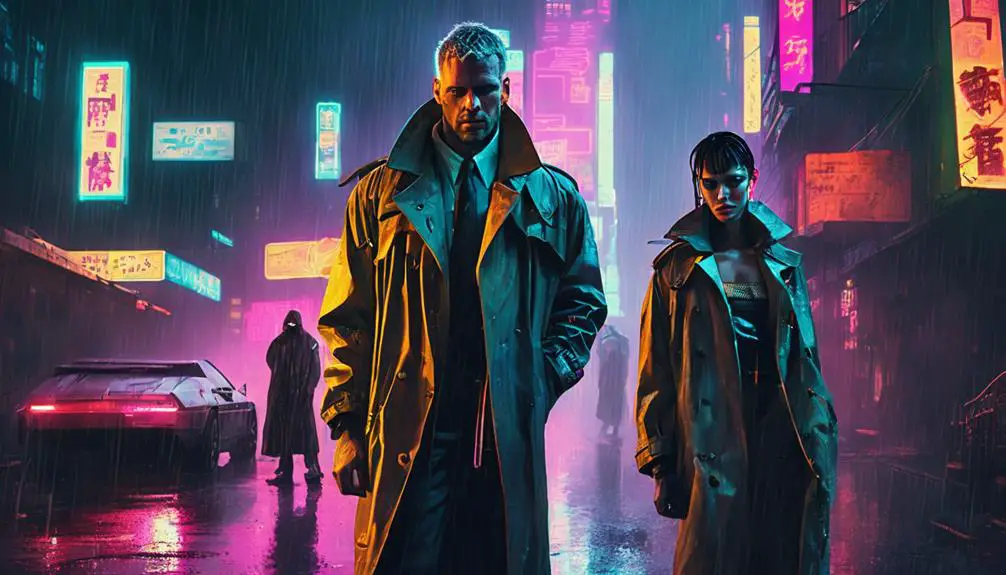
When you think of iconic sci-fi films, Blade Runner often springs to mind. Released in 1982 and directed by Ridley Scott, this groundbreaking film immerses you in a dystopian Los Angeles set in 2019, where the line between humanity and artificiality blurs. Based on Philip K. Dick's novel "Do Androids Dream of Electric Sheep?", Blade Runner explores profound themes of identity and what it means to be human through the lens of replicants—bioengineered beings created to serve.
The film's aesthetic is a striking blend of film noir genre influences, showcasing a dark, moody atmosphere filled with neon lights and rain-soaked streets. Ridley Scott's vision, combined with the incredible work of costume designers, shapes a world that feels both futuristic and eerily familiar. The costumes not only reflect the characters' personalities but also enhance the film's exploration of ethics in technology and artificial intelligence.
Despite facing mixed reviews upon its release, Blade Runner has since garnered a cult following, earning its place as one of the greatest sci-fi films ever. Its narrative and philosophical themes continue to resonate in today's discussions about technology and our relationship with it. The film's stunning visual design and thought-provoking content have inspired countless filmmakers and fashion designers, solidifying Blade Runner's impact on cinema and culture. You can't help but appreciate how this masterpiece remains relevant, challenging you to ponder what it truly means to be alive.
Iconic Costumes of Rachael
Rachael's iconic costumes in Blade Runner not only define her character but also encapsulate the film's unique aesthetic. Designed by Michael Kaplan and Charles Knode, her outfits reflect a enthralling blend of 1940s film noir with a modern twist, establishing her as a true futuristic diva in a dystopian landscape. One standout ensemble features a striking black silk and snake skin combination, perfectly accentuating Rachael's sensual and mysterious nature.
Her wardrobe doesn't stop there; Rachael's fur coat, characterized by a distinctive spiral design and crafted from vintage wool fabrics, further emphasizes her complexity and status within the narrative. The power suits she wears, complete with large shoulder pads, became significant fashion statements that resonate in contemporary trends. These outfits aren't just about looking good; they embody the film's innovative approach to costume design, steering clear of typical sci-fi clichés.
With meticulous attention to detail, Rachael's costumes combine vintage materials with modern silhouettes, showcasing a timeless elegance that enthralls viewers. Each piece contributes to her character development, enhancing the emotional depth of the story. Whether she's draped in that luxurious black silk or sporting a bold power suit, Rachael's outfits not only elevate her presence but also reflect the film's hauntingly beautiful world. The lasting impact of her iconic costumes continues to inspire fashion, proving that style can transcend time and genre.
Rick Deckard's Signature Look
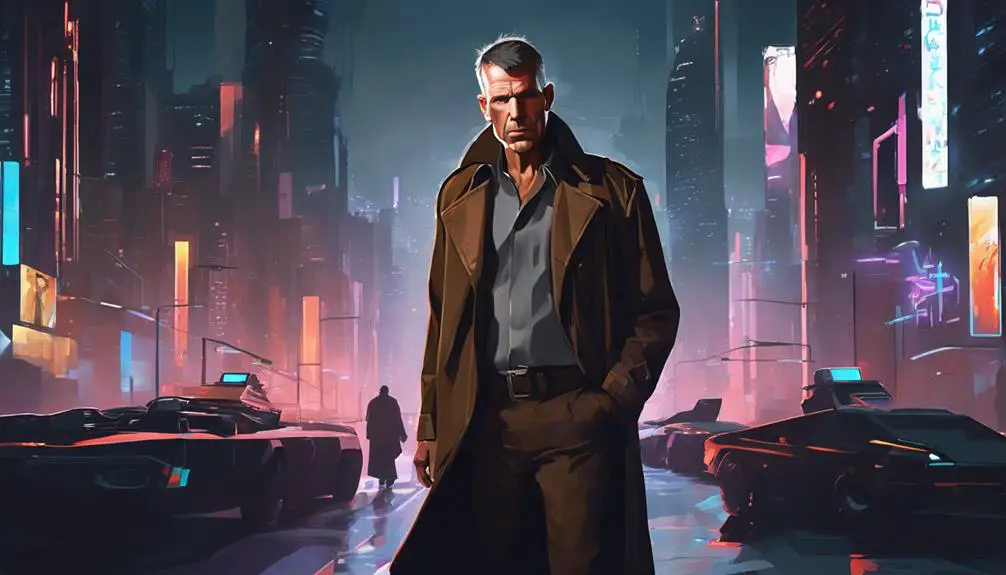
Rick Deckard's signature look perfectly balances practicality and style, showcasing his role as a gritty detective in a dystopian future. Worn by Harrison Ford, this iconic outfit features a military-style overcoat made from russet shot cotton, designed to protect against the relentless acid rain that plagues the film's landscape. The trench coat not only serves a functional purpose but also enhances Deckard's rugged character, reflecting the solitude and toughness required for his challenging job.
Underneath, he typically wears a brown, rough-woven silk suit jacket that appears weathered, paired with a tan cotton long sleeve shirt. The addition of a checkerboard tie brings a classic film noir touch, tying together his sophisticated yet rugged persona. This mix of styles creates a fascinating visual that embodies the essence of a detective traversing a dark, futuristic world.
Harrison Ford's contemporary hairstyle complements Deckard's wardrobe, emphasizing a blend of modernity with classic detective aesthetics. The overall effect is intriguing; you see a man hardened by his experiences yet distinguished by his attire. This stylish yet functional look speaks volumes about Deckard's character, representing not just a fashion statement, but a reflection of his resilience in a gritty environment.
Distinctive Styles of Supporting Characters
How do the distinctive styles of supporting characters in Blade Runner enhance the film's atmosphere? The costumes of Blade Runner's supporting characters play an essential role in creating the film's gritty atmosphere, showcasing a fascinating blend of practicality and flair. Each character's attire reflects their unique roles within this dystopian world, illustrating the diverse socio-economic backgrounds that shape their identities.
Take Hannibal Chu, for instance; his oversized Inuit parka, funky goggles, and aviator cap not only highlight his eccentricity but also underscore his scientific background as a genetic engineer. In contrast, Harry Bryant, the police captain, commands authority and presence in a naval uniform-inspired shirt, long leather trench coat, and a brown fedora, instantly asserting his dominance in the narrative.
Gaff, Deckard's colleague, adds a striking flair with his dandy style, adorned with jewelry and piercings, while incorporating fabrics reminiscent of WWII fighter pilots. This eclectic mix juxtaposes Deckard's more subdued, rugged look, emphasizing the distinctiveness of each character.
The attention to detail in these costumes enriches the world-building of Blade Runner, making each character feel authentic and memorable. By showcasing their unique styles, the film not only reflects the gritty reality of their lives but also captivates the audience with a sense of intrigue and depth. In Blade Runner, supporting characters are more than just background figures; their distinctive styles enhance the film's narrative, drawing you deeper into its complex and haunting universe.
Futuristic Fashion of Roy Batty

Roy Batty's fashion choices embody the essence of his character in Blade Runner, merging minimalism with a rebellious spirit. His striking minimalist aesthetic is defined by an all-black leather ensemble that reflects his fierce nature and complex identity. This futuristic fashion not only serves to enhance his role in the film but also resonates with contemporary design trends, drawing parallels to OFF-WHITE's Spring/Summer 2018 collection.
Batty's wardrobe features key elements that elevate his character's visual narrative:
- An all-black leather jacket, symbolizing strength and defiance
- Simple heather grey tops, offering a stark contrast to the dark dystopian backdrop
- Tailored trousers that maintain his sleek silhouette
- Minimal accessories that emphasize his rebellious spirit
- A confident stance, completing the overall look
The simplicity of Batty's clothing aligns perfectly with the emotional depth he portrays throughout the narrative. Every piece he wears speaks volumes about his existential struggles, showcasing a powerful yet tragic figure in the Blade Runner universe. The leather ensemble not only highlights his rebellious nature but also serves as a visual representation of his inner turmoil.
Batty's fashion choices are a reflection of who he is: a complex character maneuvering through a world that challenges his very existence. As you explore the futuristic fashion of Roy Batty, you'll discover how his wardrobe transcends mere clothing, becoming an integral part of his story and the thematic richness of Blade Runner.
The Influence of Film Noir
The influence of film noir is palpable throughout Blade Runner, shaping its visual style and narrative structure. This futuristic classic brilliantly blends traditional noir elements with a dystopian setting, creating an atmosphere that's both haunting and enchanting. You'll notice how cinematographer Jordan Cronenweth employs high contrast lighting and unconventional angles, echoing the iconic cinematography of classic film noir. It's this moody ambiance that draws you deeper into the world of Rick Deckard, the weary protagonist clad in his signature trench coat, which serves as a nod to the detective archetypes of the 1940s. The film's visual motifs parallel the evolution of vintage fashion, similar to how vintage Adidas logos signify cultural significance and style. As you explore the film, you can't help but be intrigued by the femme fatales, like Rachael, whose alluring and mysterious outfits reflect the timeless roles found in classic noir cinema. Their presence adds layers of complexity to the narrative, blurring the lines between trust and betrayal. The relentless nighttime setting, coupled with rain-soaked streets, enhances the film's noir charm while reinforcing themes of existentialism and moral ambiguity.
Lasting Impact on Fashion
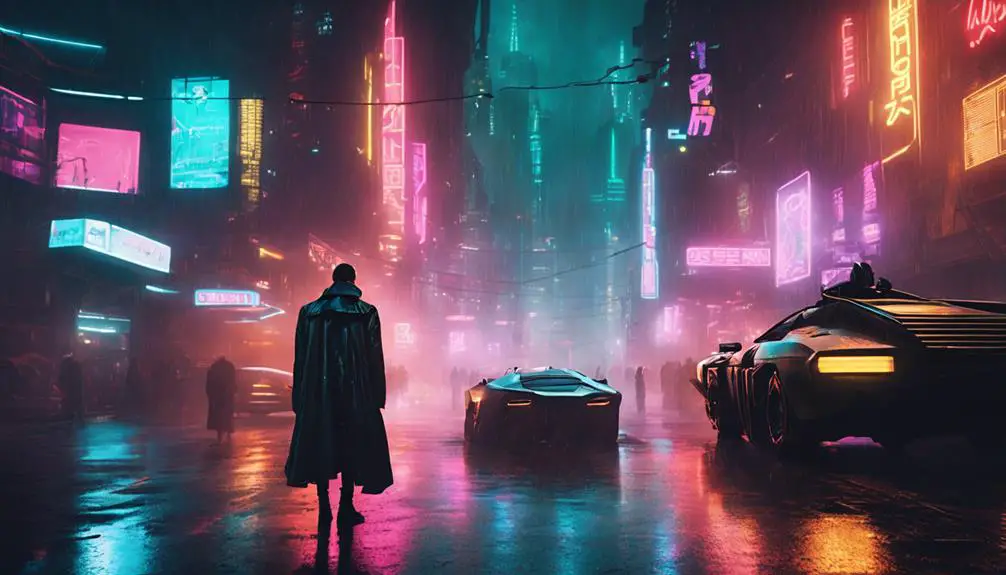
While many films have influenced fashion trends, Blade Runner stands out for its unique melding of vintage and futuristic styles that continues to shape contemporary design. The film, with its striking aesthetic crafted by costume designer Michael Kaplan, has left a lasting legacy in the fashion world. Its iconic costumes, like Rachael's power suits and Deckard's rugged trench coat, remain pivotal references in modern collections, showcasing silhouettes and textures that evoke a blend of rebellion and sophistication.
Designers have drawn inspiration from Blade Runner's themes of dystopia and identity, creating works that resonate with the gritty urban environment portrayed in the film. You might see its influence in fashion shows, where designers present collections that echo the film's visual elements. This connection highlights the film's profound impact on contemporary style.
Here are a few ways Blade Runner continues to inspire fashion today:
- Silhouettes: Modern designs often mimic the film's unique shapes.
- Textures: Leather, metallics, and layered fabrics reflect the film's aesthetic.
- Themes of Rebellion: Many collections embody the gritty, rebellious spirit of the characters.
- Fashion Exhibitions: Blade Runner is frequently celebrated in retrospectives exploring cinema and style.
- Cultural Relevance: Designers like Alexander McQueen and Raf Simons reference the film's iconic looks in their work.
In essence, Blade Runner's groundbreaking vision not only redefined its era but also continues to guide today's fashion narratives, showcasing its enduring allure and relevance.
Frequently Asked Questions
What Is the Fashion in Blade Runner?
In Blade Runner, you'll find a mix of neon lights and dystopian themes. Layered clothing with urban textures, vintage accessories, and futuristic fabrics create a unique style that's both timeless and reflective of its gritty setting.
What Is the Aesthetic of Blade Runner Called?
The aesthetic of Blade Runner is often called cyberpunk, showcasing neon lighting, dystopian themes, and futuristic textiles. It embodies character symbolism and urban decay, creating a visually striking world that merges past and future seamlessly.
What Type of Style Is Blade Runner?
Blade Runner showcases a neon dystopia, blending cyberpunk influences with retro futurism. Its film costume reflects streetwear evolution and character symbolism, creating a unique style that profoundly impacts fashion and visual storytelling in cinema.
What Year Was Blade Runner Set In?
You'll find that Blade Runner's set in 2019, showcasing future technology within a dystopian society. The urban landscapes, character motivations, and replicant design influence the film's lasting impact on science fiction and thematic exploration.
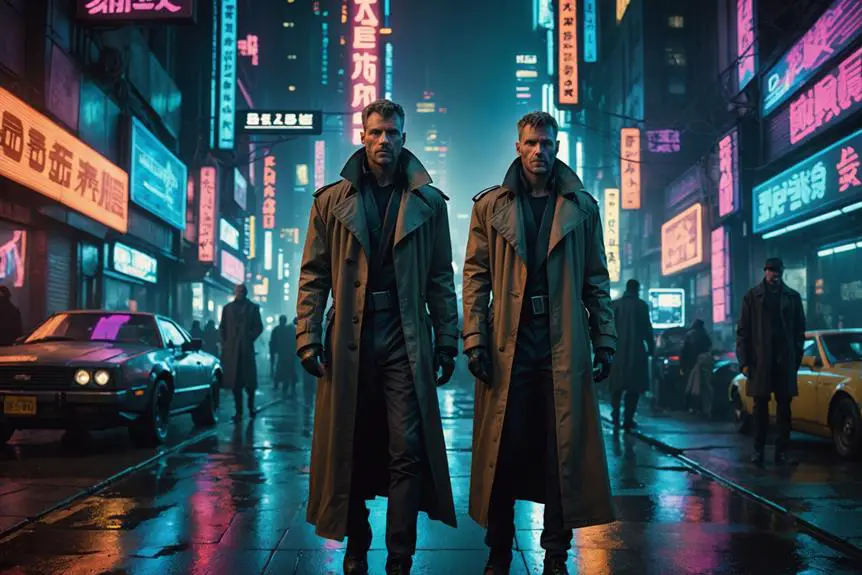

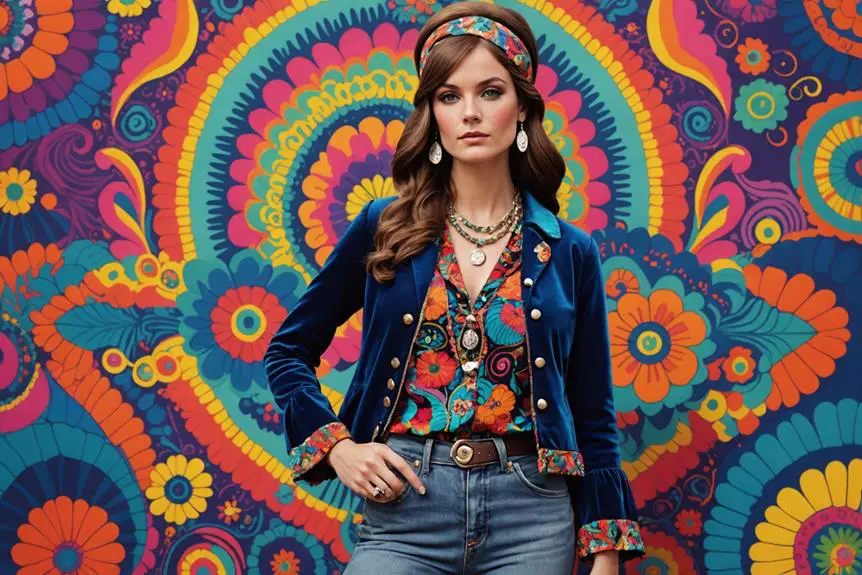
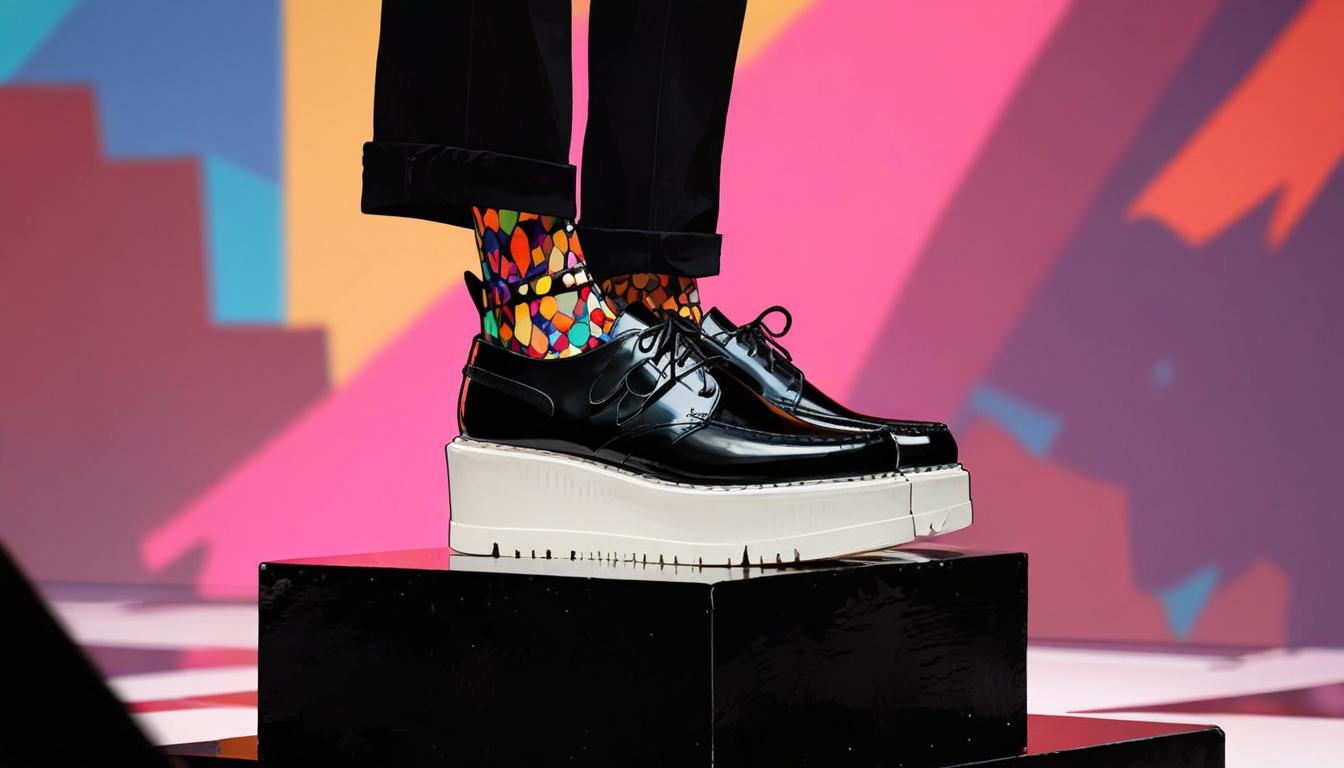
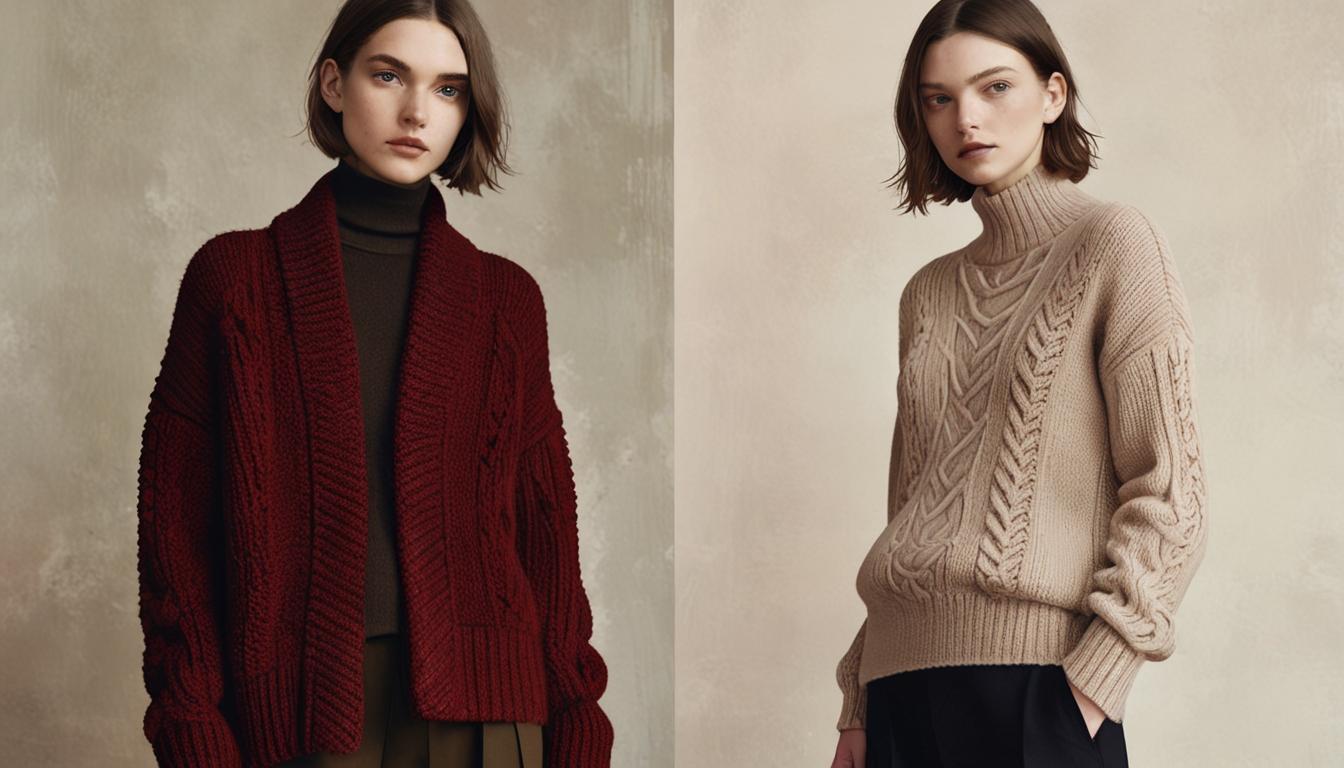
I think this is among the most important information for me.
And i’m glad reading your article. But wanna remark on few general things,
The web site style is wonderful, the articles is
really nice : D. Good job, cheers
meilleur casino en ligne
Thanks for any other fantastic article. The place else could anyone get that
kind of info in such an ideal manner of writing? I
have a presentation next week, and I am at the look for such information.
casino en ligne
Quality content is the key to attract the people to go
to see the web site, that’s what this site is providing.
meilleur casino en ligne
Thankfulness to my father who shared with me on the topic of
this web site, this website is actually remarkable.
casino en ligne
My relatives every time say that I am wasting my time here at web, however I know I am getting know-how
every day by reading such nice content.
casino en ligne
Thanks for any other fantastic post. The place
else may anybody get that type of information in such an ideal method of writing?
I have a presentation subsequent week, and
I’m on the look for such info.
casino en ligne
I’m excited to find this web site. I want to to thank you for ones time for this fantastic read!!
I definitely liked every part of it and i also have you bookmarked to check out new information in your website.
meilleur casino en ligne
Hi there would you mind letting me know which web host
you’re utilizing? I’ve loaded your blog in 3 completely different
browsers and I must say this blog loads a lot quicker then most.
Can you suggest a good hosting provider at a fair price?
Thanks a lot, I appreciate it!
casino en ligne fiable
Link exchange is nothing else however it is just placing the
other person’s blog link on your page at suitable place and other person will also do
similar in favor of you.
casino en ligne fiable
Thank you a bunch for sharing this with all of us you really understand what you are talking about!
Bookmarked. Kindly additionally seek advice from my site =).
We could have a hyperlink exchange agreement among us
casino en ligne